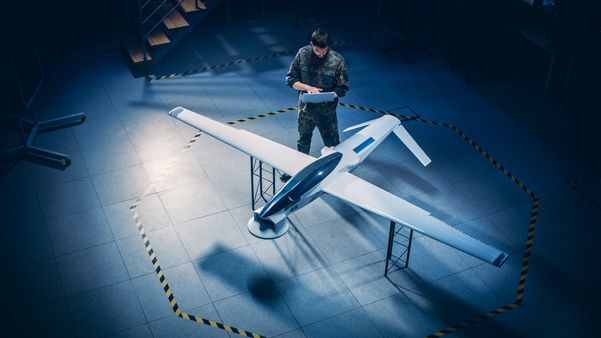It may not look like much right now, but Textron's (TXT 0.03%) new "Scorpion" fighter jet can fly. And on Thursday, Textron proved it.

This is Scorpion. Source: Textron AirLand
Taking off from McConnell Air Force Base at 9:05 a.m. central time, test pilot Dan "Shaka" Hinson put the new plane through its paces, flying continuously for 85 minutes before landing back at base.
And not only was the flight "fantastic," as Hinson put it: Scorpion broke a sound barrier or two in going from paper concept to flying airplane in under two years flat. For comparison, it took Lockheed Martin (LMT +1.02%) roughly four years to get its F-35 fighter jet airborne. In less time than that, Textron says it could already be delivering combat jets to customers!
There's just one thing
Of course, before it can do that, Textron needs to find some customers. According to company management, if development and the certification process proceed at their present paces, Scorpion could be in production within as little as 18 months -- once it finds a buyer. So who might want it?
Well, here's what we know. Powered by twin turbofan engines, the Scorpion can reach top speeds upwards of 500 mph. That won't be fast enough to keep up with cutting edge fifth-generation fighters like Lockheed's F-35, or even a fourth generation bird like Boeing's (BA +2.74%) F/A-18. But 500 mph would be plenty fast to run down something like Embraer's (ERJ 0.86%) new A-29 Super Tucano prop-driven plane. That alone could make the plane attractive to South American nations bordering the rising power of Brazil, Embraer's home state.

Brazilian Super Tucanos on patrol. Source: Wikimedia Commons
Scorpion's beefy engines also enable the plane to carry a sizable payload of ordnance. The plane's rated to carry 3,000 pounds of bombs internally, and boasts six "hard points" along its wings for carrying extra fuel tanks and surface-to-surface or surface-to-air missiles. While the Scorpion might not last long in a dogfight against "real" fighter jets, the plane could pack a punch supporting ground troops in regions of low-intensity conflict.
One final point: Reviewing the Scorpion recently, military mag DefenseNews.com sounded particularly impressed with the plane's "82 cubic feet of modular space for communications, electronic warfare and intelligence, surveillance, and reconnaissance gear." This would make the Scorpion ideally suited for border patrol, maritime surveillance and counter-narcotics missions, potentially permitting the plane to be used as a stand-in for something like the Boeing P-8 Poseidon -- which at a list price of over $200 million costs roughly 10 times Scorpion's expected cost.

Boeing's new Poseidon -- pretty, but pricey. Source: Wikimedia Commons
Speaking of which, you may have heard that Congress passed a new compromise budget bill this week. If approved by the Senate, it could put $22.5 billion back into the defense budget this year -- money that would otherwise have been cut by sequestration. Based on our best guess at what Textron will charge for its new Scorpion, that would be enough money to buy... about 1,000 new Scorpions.
In theory, and if Congress should be so inclined, of course. For now, for Textron shareholders, it's still a matter of "fingers crossed," as Scorpion awaits clearance for its sales to take off.

Scorpion still waiting on the tarmac to see its first sale. Source: Textron AirLand









